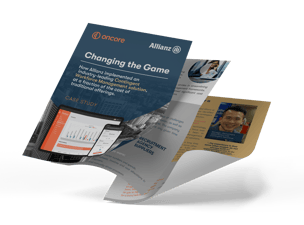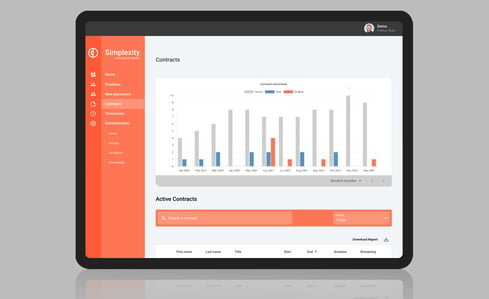As we head into FY25–26, Australia’s recruitment industry finds itself in a period of rapid change. Ongoing global uncertainty has made many businesses more cautious about hiring, yet there are clear areas of growth and fresh opportunities taking shape. For recruitment agency leaders, keeping up with these shifts is essential. In this article, Oncore breaks down the major trends - from longer hiring cycles and a push for specialisation to the steady rise of contract work, new industry hot spots, and what today’s contractors expect, to help you understand where the market is moving next.
Global Headwinds and Emerging Strategies
After a turbulent 2024, the global recruitment market remains mixed. Many large staffing firms continue to report economic uncertainty, delayed hiring decisions, and cautious candidates unwilling to jump jobs in unstable times. Long hiring cycles have become the norm: employers want talent, but they are more selective than ever, often waiting for “unicorn” candidates who perfectly fit narrow specifications.
Yet leading agencies aren’t standing still. Top performers are pivoting, focusing on high-margin specialisations in niche verticals where they can deliver deeper client value and better margins. Think AI talent for legal services or compliance consulting for banks. Many pair these specialisations with broader services like consulting, project management, and end-to-end staffing solutions, positioning themselves as strategic partners rather than transactional vendors. Agencies able to offer comprehensive workforce solutions are winning market share by cementing long-term client relationships.
One clear game-changer is the rise of AI-driven recruiting. What was once hype is now a daily reality. Forward-thinking firms are deploying AI tools to automate sourcing, outreach, matching, and onboarding - boosting productivity and reducing time-to-fill. But success with AI demands strong data hygiene and a clear digital strategy. Clients increasingly expect a tech-forward approach, from digital talent marketplaces to self-service staffing portals. For agency leaders, embracing AI and data-driven recruiting is no longer optional; it’s now a competitive necessity.
Australia’s Contingent Workforce on the Rise
One area where Australia mirrors global trends is the shift toward contingent hiring. With permanent hiring hesitancy persisting, employers are turning to contractors and temporary staff to stay agile. Contract roles have proven resilient, from tech contractors to seasonal trades, demand remains steady.
It’s not just employers driving this shift. Talent is increasingly open to contracting. Oncore’s latest State of Contracting survey of over 550 Australian contractors highlights a clear trend:
-
83% say competitive pay is “very important”.
-
75% rate flexible hours and location as critical.
-
64% prefer hybrid work, with fewer wanting fully remote roles as some appetite for in-person collaboration returns.
Variety, autonomy, and alignment with company values also matter deeply. Today’s contractors are discerning consumers of work, they will walk away from roles that don’t meet their standards for pay, flexibility, respect, and growth. For agencies, this means understanding and communicating these expectations is essential for attracting and retaining top talent.
Agencies are evolving in response. The recruiter’s role is shifting from intermediary to trusted career partner - one who understands a contractor’s skills, career goals, and lifestyle needs. Transparent communication, regular check-ins, constructive feedback, and industry expertise are now minimum expectations. Building trust and loyalty means investing time in candidate relationships.
Compliance and Contractor Care as Differentiators
In a market where compliance is under the microscope, contractor care is more than good practice - it’s a competitive edge. Clients in regulated sectors like finance, government, and defence demand airtight payroll, tax, and legal compliance. Contractors, too, expect prompt, accurate pay, proper superannuation, and adherence to Fair Work standards. Agencies that get this right remove a major pain point for both clients and contractors, building trust and winning repeat business.
Sectors to Watch: Clean Energy and Defence
Two sectors stand out as growth engines heading into FY25–26: clean energy and defence.
Clean Energy
Australia’s renewables sector is booming as the nation accelerates its energy transition. Government and corporate investment in large-scale solar, wind, hydro, and battery storage projects is creating thousands of contractor roles. Massive projects like Queensland’s Western Downs Green Power Hub and NSW’s Waratah “Super Battery” are typical of what’s to come. Engineers, technicians, project managers, and trades will be in steady demand as states push ahead with ambitious clean energy targets.
Defence
Defence spending is ramping up too, with the government’s FY2024–25 defence budget rising to A$55.7 billion — up 6.3% year-on-year. Multi-decade programs, from AUKUS submarines to cybersecurity upgrades, are fuelling demand for specialist project-based talent. Roles span engineers, IT security, systems developers, and skilled trades. However, agencies looking to break into defence must meet strict compliance and security standards and have the patience for long sales cycles that lead to stable, multi-year work once secured.
Regional Trends: A State-by-State Lens
Recruitment conditions vary widely across Australia’s states:
-
Queensland, South Australia, and Western Australia are leading job demand growth, with job ads about double pre-pandemic levels.
-
NSW and Victoria, while still home to large absolute job volumes, have cooled more sharply but remain hubs for white-collar and services roles.
-
Queensland benefits from renewable energy projects and major infrastructure tied to the 2032 Brisbane Olympics.
-
WA continues to thrive on mining and engineering, plus defence-related shipbuilding.
-
South Australia combines defence and space industry strength with leading renewables integration.
-
Tasmania, the ACT, and the NT each offer niche project opportunities, ranging from hydro expansion to government contracting and remote area infrastructure.
Smart agencies will align specialisations and resources to each state’s growth sectors, riding the wave of local demand.
Staying Ahead of the Curve
All these trends were front and centre at Oncore’s recent Scale Up Session in Sydney, where recruitment leaders gathered to discuss the future of the market. The message was clear: staying informed and adaptable is key. Industry roundtables, webinars, and peer networking offer invaluable insight-sharing to help agencies move proactively, not reactively.
As FY25–26 unfolds, the road ahead holds both challenges and new opportunities. Agencies that stay close to the market, invest in tech and compliance, and build deep candidate relationships will be best positioned to thrive. Oncore will continue to bring industry leaders together to share knowledge and spark ideas, because in recruitment, staying ahead is a team sport.
Let’s navigate FY25–26 with foresight, agility, and a commitment to shaping what’s next.
✅ Ready to share insights with your network?
Join the conversation at Oncore’s next Scale Up Session and be part of the community driving Australia’s recruitment future.












_11zon%20(1).jpg?width=302&height=124&name=linkedin-sales-solutions-vqWWOnA6--M-unsplash%20(2)_11zon%20(1).jpg)








